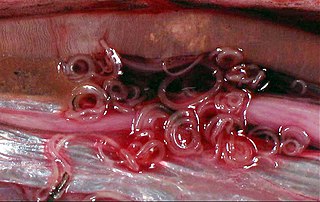Leptosomatidae is a family of benthic marine nematode worms.

Enoplea (enopleans) is a class, which with the classes Secernentea and Chromadorea make up the phylum Nematoda in current taxonomy. The Enoplea are considered to be a more ancestral group than the Chromadorea, and researchers have referred to its members as the "ancestrally diverged nematodes", compared to the "more recently diverged nematodes" of Chromadorea.

Heterorhabditis is a genus of nematodes belonging to the order Rhabditida. All species of this genus are obligate parasites of insects, and some are used as biological control agents for the control of pest insects.

Adenophorea or Aphasmidia was a class of nematodes (roundworms). It has been by and large abandoned by modern taxonomy, because there is strong evidence for it being a motley paraphyletic group of unrelated lineages of roundworms.

The Chromadorea are a class of the roundworm phylum, Nematoda. They contain a single subclass (Chromadoria) and several orders. With such a redundant arrangement, the Chromadoria are liable to be divided if the orders are found to form several clades, or abandoned if they are found to constitute a single radiation.
Pratylenchus brachyurus is a plant parasitic nematode.

Subclass Spiruria comprises mostly parasitic secernentean nematodes. In an alternate classification, they are treated as suborder Spirurina, with the orders listed here being ranked as infraorders.

Diplogasterida was an order of nematodes. It was sometimes placed in a monotypic subclass Diplogasteria, but molecular phylogenetic evidence has shown it to be embedded in the family Rhabditidae. The confusion of having a hierarchical nesting of groups that were formerly mutually exclusive has led to a profusion of names. Although completely revised taxonomy of nematodes that builds on recent classification systems as well as recent phylogenetic evidence is still necessary, most contemporary taxonomic studies now treat all groups listed under "Diplogasterina" below as a single family, Diplogastridae.

The nematodes or roundworms constitute the phylum Nematoda, with plant-parasitic nematodes also known as eelworms. They are a diverse animal phylum inhabiting a broad range of environments. Less formally, they are categorized as Helminths, but are taxonomically classified along with arthropods, tardigrades and other moulting animals in the clade Ecdysozoa, and unlike flatworms, have tubular digestive systems with openings at both ends. Like tardigrades, they have a reduced number of Hox genes, but their sister phylum Nematomorpha has kept the ancestral protostome Hox genotype, which shows that the reduction has occurred within the nematode phylum.
Hoplolaimus galeatus is a plant pathogenic nematode.
The Enoplia are a subclass of nematodes in the class Enoplea.
Qudsia Tahseen is a Professor of Zoology at Aligarh Muslim University and teaches Animal Ecology as well as Nematology to the students of the Masters programme. Her areas of research include taxonomy and developmental biology of terrestrial and aquatic nematodes. Her thrust areas are Biodiversity, Taxonomy, Ecology and developmental biology of soil and fresh water nematodes. She is a fellow of two national science academies of India.

Pristionchus is a genus of nematodes (roundworms) in the family Diplogastridae that currently includes more than 50 described species. They are known mainly as non-parasitic associates of insects, especially beetles, while others have been reported from soil, organic matter, or rotting wood. The genus includes P. pacificus, a satellite model organism to the well-studied nematode Caenorhabditis elegans.
Paratrichodorus is a genus of terrestrial root feeding (stubby-root) nematodes in the Trichodoridae family (trichorids), being one of five genera. They are economically important plant parasites and virus vectors. The females are didelphic, and are distributed worldwide.
Triplonchida is an order of terrestrial nematodes, and is one of two orders making up the subclass Enoplia.
Diphtherophorina is a suborder of terrestrial nematodes, being one of three that constitute suborder Triplonchida.
Trichodoridae is a family of terrestrial root feeding nematodes, being one of two that constitute suborder Triplonchida. They are economically important plant parasites and virus vectors.

Trichodorus is a genus of terrestrial root feeding (stubby-root) nematodes in the Trichodoridae family (trichorids), being one of five genera. They are economically important plant parasites and virus vectors.
Bunonematidae is a family of nematodes in the order Rhabditida.








